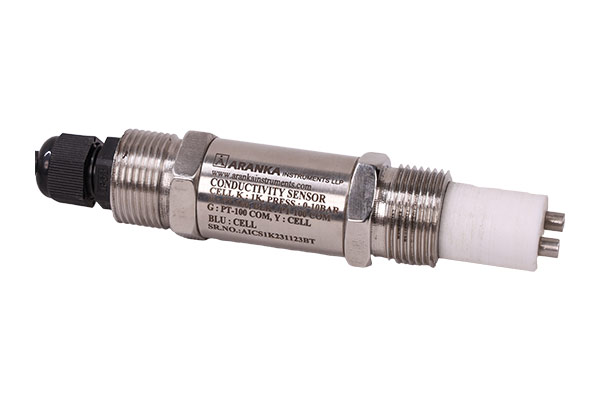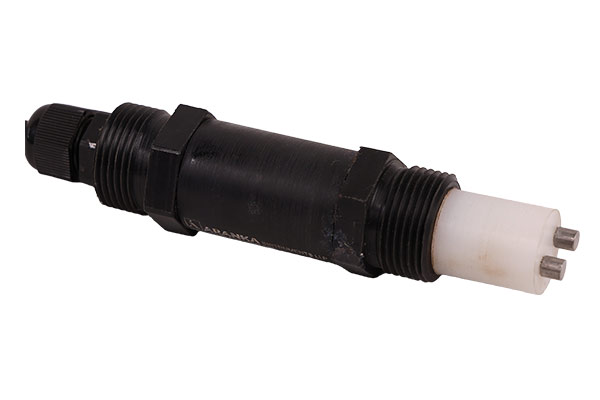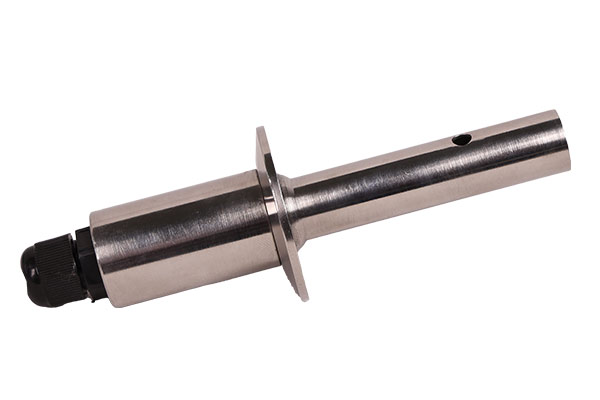ACS Conductivity Sensor
The ACS Conductivity Sensor, manufactured and supplied by Aranka Instruments LLP, a leading ACS Conductivity Sensor manufacturer and supplier in Ahmedabad, Gujarat, India, is designed for accurate measurement of a solution’s electrical conductivity. Its working principle is based on detecting the ability of a liquid to conduct electric current, which reflects its ionic concentration and overall purity. Built with high-quality electrodes and temperature-compensated design, the sensor ensures precise and stable readings in varied process conditions. Ideal for water treatment, chemical, pharmaceutical, and food & beverage industries, the ACS Conductivity Sensor offers long-term reliability, corrosion resistance, and smooth integration with Aranka’s range of conductivity controllers for effective monitoring and process automation.



working principle:
- Electrodes: A typical conductivity sensor consists of two or more electrodes made of conductive materials. These electrodes are usually placed at a fixed distance from each other.
- Electrical Potential: An electrical potential (voltage) is applied across the electrodes. This creates an electric field in the solution between the electrodes.
- Ion Movement: In a solution, various ions (charged particles) may be present, contributing to the conductivity of the solution. These ions can be positively charged (cations) or negatively charged (anions). When the electrical potential is applied, these ions start to move towards the oppositely charged electrode.
- Current Flow: As ions move through the solution towards the electrodes, they carry an electric current. The higher the concentration of ions in the solution, the greater the current flow, and consequently, the higher the conductivity.
- Measurement: The sensor measures the current flowing between the electrodes. The conductivity of the solution is then calculated using Ohm’s Law (I = V/R), where I is the current, V is the voltage, and R is the electrical resistance. Conductivity (σ) is often expressed in Siemens per meter (S/m) or microsiemens per centimeter (μS/cm).
- Temperature Compensation: Since conductivity is also temperature-dependent, many conductivity sensors include temperature compensation mechanisms. This ensures that variations in temperature do not significantly affect the accuracy of the conductivity measurement.
- Easy to install.
- it work for High Temperature.
- SS316 MOC.
- Tough Body.
- PTFE Isolation.
| Cell K | 0.01K, 0.1K, 1K, 10K | |
| Sensor MOC | S.S.316 | |
| Sensor Isolation MOC | PTFE/P.P./Nylon | |
| Connection | 3/4″ BSP Male/ Try Clamp | |
| Cable Length | 6 meter | |
| Cable | 5 Core Shielded | |
| Operating Pressure | Ma. 15 Bar | |
| Operating Temperature | SS316/PTFE | -20 ~ 200’C |
| Nylon/Nylon | -20 ~ 80’C | |
| P.P/Nylon | -20 ~ 80’C | |
1. Water Quality Monitoring:
- Drinking Water Quality: Conductivity sensors are used to assess the purity of drinking water by measuring the concentration of dissolved ions.
- Wastewater Treatment: Monitoring the conductivity of wastewater helps in determining the effectiveness of treatment processes.
2. Industrial Processes:
- Chemical Processing: In industries where precise control of ion concentrations is critical, conductivity sensors are employed to monitor and regulate the production processes.
- Food and Beverage Industry: Monitoring the conductivity of solutions is important in processes like brewing, where water quality affects the final product.
3. Environmental Monitoring:
- Aquatic Ecosystems: Conductivity measurements in rivers, lakes, and oceans provide insights into the salinity and health of aquatic ecosystems.
- Soil Salinity: In agriculture, conductivity sensors can be used to assess soil salinity, helping farmers make informed decisions about crop management.
4. Laboratory Research:
- Chemical Analysis: Conductivity sensors are utilized in laboratories for analyzing the concentration of ions in various solutions.
- Biochemical Studies: In biological and biochemical research, conductivity measurements can be employed to study the behavior of biomolecules in solution.
5. Cooling Systems:
- Cooling Towers: Monitoring the conductivity of water in cooling systems is crucial to prevent scale formation and corrosion, ensuring the efficient operation of the cooling equipment.
6. Quality Control in Manufacturing:
- Electronics Industry: Conductivity sensors play a role in quality control during the manufacturing of electronic components, ensuring that the materials used meet the required standards.
7. Pharmaceutical Production:
- Drug Manufacturing: In pharmaceutical processes, where precise control of chemical reactions is essential, conductivity sensors help maintain the desired conditions.
8. Power Plants:
- Boiler Water Monitoring: Conductivity sensors are used to monitor the quality of water in boiler systems, helping to prevent scale formation and improve heat transfer efficiency.
9. Biotechnology:
- Fermentation Processes: In biotechnology applications, conductivity sensors can be used to monitor and control fermentation processes, ensuring optimal conditions for microbial growth.
Frequently Asked Questions (FAQs)
What is a conductivity sensor?
A conductivity sensor measures the electrical conductivity of a solution, which indicates how well the solution conducts electric current. It does so by applying a voltage across electrodes and measuring the resulting current—higher ionic concentration leads to higher conductivity.
Why is temperature compensation needed?
Conductivity changes with temperature (ions move more at higher temperatures). A good sensor includes temperature compensation to correct readings to a standard reference temperature so that variations don’t distort measurements.
What materials are used for the sensor and isolation?
-
Sensor body / electrodes: Stainless Steel 316 (SS316)
-
Isolation / insulator materials: PTFE, P.P. (Polypropylene), Nylon
What are the connection and cable specifications?
-
Connection type: 3/4″ BSP male or tri-clamp
-
Cable: 5-core shielded cable, length of 6 m standard
What are the operating pressure and temperature limits?
-
Maximum pressure: 15 bar
-
Temperature range (SS316/PTFE): –20 °C to +200 °C
-
For Nylon / P.P. versions: –20 °C to +80 °C
What “Cell K” values / cell constant options are available?
Cell constants: 0.01K, 0.1K, 1K, 10K (depending on sample conductivity range)
What are typical applications?
-
Water quality monitoring (drinking water, wastewater)
-
Industrial chemical processes requiring precise ion concentration control
-
Food & beverage, environment monitoring, cooling systems, pharmaceuticals
-
Monitoring conductivity in RO / DM plants, boiler water, and more
What certifications / approvals does the ACS Sensor have?
-
CE Approved
-
ISO 9001:2025 certification

